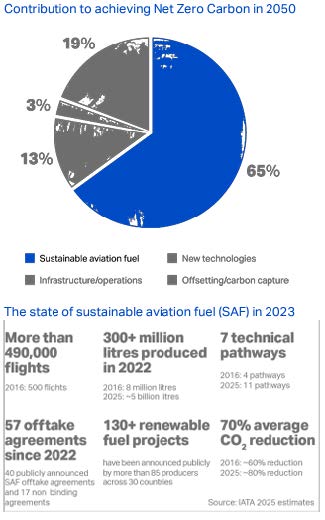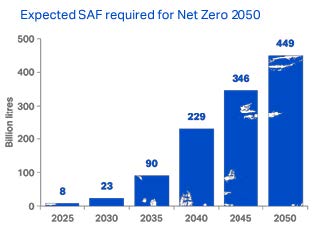The International Air Transport Association (IATA), International Civil Aviation Organization (ICAO), and Civil Air Navigation Services Organization (CANSO) are all aiming for “net-zero” aviation by 2050. That is a very bold commitment that is clearly easier said than done. The focus of the commitment is on CO2 reduction given the nascent science on non-CO2 emissions such as nitrogen oxides and soot that can cause radiation and affect the climate.
In order to achieve net zero flying largely depends on the development and expansion of the production of “sustainable aviation fuel” (SAF). SAF is produced from sustainable feedstocks, such as cooking oil and animal waste fat, all of which are not yet abundant enough at this time to meet eventual demand. Throw in sustainable fuel demand from other industries such as marine and road transport and the goal seems even more challenging.
For airlines already facing low profitability due to recently rising oil prices, the shift toward the use of SAF will only make meeting profitability goals more difficult. And given that aircraft have quite long useful lives, lengthy development times and use a large amount of energy, the aviation industry is one of hardest sectors to decarbonize.
Current State of SAF
IATA estimates that SAF could contribute around 65% of the reduction in emissions needed by aviation to reach net-zero by 2050. They list the following as challenges to the rapid development and deployment of SAF that could be addressed through policy measures:
- Insufficient policy support in promoting the scaling up for SAF
- Absence of a harmonized approach in SAF accounting methodology
- Lack of access to SAF in existing fuel logistics and airport infrastructure
- Lack of understanding of SAF as an insetting measure in addition to carbon offsets
- Limited availability of cost-effective and sustainable SAF feedstock and feedstock treatment infrastructure


We have seen several announcements over the past few years regarding partnerships and supply agreements between airlines/airline manufacturers and SAF producers. Most recently, Airbus joined Japan’s ACT FOR SKY, a voluntary organization that commercializes, promotes and expands the use of locally-produced sustainable aviation fuel — to support building a resilient supply chain in the country. In 2021, Boeing made a commitment to build commercial airplanes that would be capable and certified to fly on 100% SAF by 2030.
Back in August, Delta Airlines joined up with Bank of America, Xcel Energy, Ecolab and others to form the GREATER MSP-Partnership to establish the first large-scale SAF Hub in the U.S. with collaboration among key players committed to scaling SAF production to replace conventional jet fuel. Last May, Delta also made a multi-million commitment to purchase up to 10 million gallons of SAF from Shell Aviation over a two-year period for use at its Los Angeles hub.
American Airlines has announced commitments of 620 million gallons of SAF from 2025-2030. They are an anchor partner of Breakthrough Energy Catalyst, a network that is working to accelerate the development and commercialization of critical technologies for decarbonization, including SAF.
United Airlines announced this month a 20-year deal with Cemvita, a Houston-based start-up that produces sustainable aviation fuel (SAF) from recycled carbon dioxide. Under the agreement, Cemvita will supply the carrier with 50 million gallons per year over the period. What is unique about Cemvita is that its production process uses microbes to synthetically recreate plant photosynthesis, converting carbon dioxide from other companies’ waste streams into non-fossil fuel, plastics, and chemicals. The company claims sourcing and using carbon dioxide in this way would not only produce more SAF with far less land, water, and electricity requirements than traditional SAF production methods, but would also be more reliable and efficient than relying on crops.
Frontier Airlines, along with Indigo Partners and others, announced earlier this year an investment in CleanJoule, a US based startup focused on the production of SAF. As part of the consortium’s investment, Frontier Airlines, Wizz Air and Volaris have signed binding agreements to purchase up to 90 million gallons of SAF. The principals of Indigo Partners will also receive a board seat on CleanJoule’s Board of Directors.
Alaska Airlines, Southwest Airlines, and most all other airlines have also been making investments and commitments to purchase SAF in significant quantities through a variety of private and public partnerships. It’s seems clear to me that the airline industry is committed to achieving net-zero carbon emissions by 2050.
Cost of SAF vs. Fossil-Based Jet Fuel
Only half-dozen companies make commercial quantities of SAF, which accounts for about 0.1% of the world’s jet fuel supply and costs at least twice as much to produce. Critics contend that United and other US airlines have made big commitments but are baulking at higher prices for cleaner fuels and lobbying against mandates which stands in the way of meaningful progress. They call it “green-washing” for lack of a better term. It comes down to the age-old adage, watch what they do, not what they say.
A unique approach to the cost problem is the creation of SAF Certificates (SAFc). Companies seeking ways to reduce their carbon footprint and emissions associated with corporate travel will welcome the SAFc framework developed through the World Economic Forum’s Clean Skies for Tomorrow initiative, which will allow organizations to claim sustainable aviation fuel emissions reductions if they elect to shoulder the increased cost of the SAF.
The rapid rate at which the SAFc framework is being formed is also apparent in the “demand signals” shown through the partnerships forged between Clean Skies for Tomorrow and corporations such as Deloitte, United Airlines, Microsoft, Boeing and BlackRock who are set to pilot the SAFc model. It is a rapidly moving initiative that aims to have the system globally adopted and internationally recognized in three years’ time.
Wrapping Up
As I did my research on the push to net-zero carbon by 2050, I realized just how complex and challenging it will be for the aviation industry to achieve that goal. I imagine there will be some significant consolidation among SAF consortiums over the next 5-10 years so investments can be more concentrated in the most promising and cost-efficient production methods. The SAFc framework is unique in that it gives large corporations the opportunity to try and change their behavior with regard to commercial travel expenditures by being willing to bear some of the cost of SAF production. It will be interesting to watch and see how many other corporations step forward to do the same as Microsoft and others have already done. Given our current economic environment, companies are quite reluctant to voluntarily add to their expense lines given the constant demand from investors for maximum profits.
